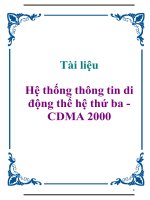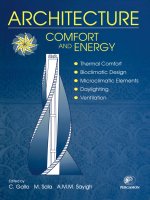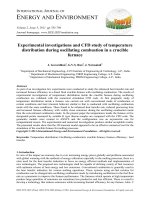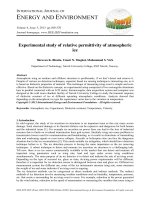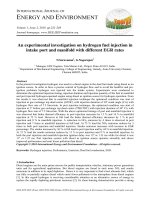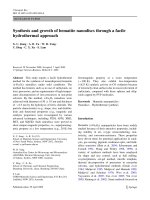experimental approach cdma & interference(from architecture through vlsi)
Bạn đang xem bản rút gọn của tài liệu. Xem và tải ngay bản đầy đủ của tài liệu tại đây (7.07 MB, 290 trang )
This page intentionally left blank
An Experimental
Approach to CDMA and
Interference Mitigation
From System Architecture to Hardware
Testing through VLSI Design
by
Luca Fanucci
Italian National Resourch Council,
Italy
Filippo Giannetti
University of Pisa,
Italy
Marco Luise
University of Pisa,
Italy
and
Massimo Rovini
European Space Research and Technology Centre, ESA/ESTEC,
Directorate of Technical and Operating Support, Communication System
Section TOS-ETC; Keplerlaan 1, 2200 AG Noordwijk ZH, The Netherlands.
t: +31 71 5656156, e:
KLUWER ACADEMIC PUBLISHERS
NEW YORK, BOSTON, DORDRECHT, LONDON, MOSCOW
eBook ISBN:
1-4020-2537-8
Print ISBN:
1-4020
-7723-8
©2004 Springer Science + Business Media, Inc.
Print ©2004 Kluwer Academic Publishers
All rights reserved
No part of this eBook may be reproduced or transmitted in any form or by any means, electronic,
mechanical, recording, or otherwise, without written consent from the Publisher
Created in the United States of America
Visit Springer's eBookstore at:
and the Springer Global Website Online at:
Dordrecht
Authors
Luca Fanucci was born in Montecatini Terme, Italy, in 1965. He received
the Doctor Engineer (summa cum laude) and the Research Doctor degrees,
both in electronic engineering, from the University of Pisa, Pisa, Italy, in
1992 and 1996, respectively. From 1992 to 1996, he was with the European
Space Agency's Research and Technology Center, Noordwijk, The Nether-
lands, where he was involved in several activities in the field of VLSI for
digital communications. He is currently a Research Scientist of the Italian
National Research Council in Pisa. Since 2000, he has been an Assistant
Professor of Microelectronics at the University of Pisa, Italy. His main inter-
ests are in the areas of System-on-Chip design, low power systems, VLSI
architectures for real-time image and signal processing, and applications of
VLSI technology to digital and RF communication systems.
Filippo Giannetti was born in Pontedera, Italy, on September 16, 1964. He
received the Doctor Engineer (cum laude) and the Research Doctor degrees
in electronic engineering from the University of Pisa, Italy, in 1989 and from
theUniversity of Padova, Italy, in 1993, respectively. In 1988/89, he spent a
research period at TELETTRA (now ALCATEL), in Vimercate, Milan, It-
aly, working on error correcting-codes for SONET/SDH radio modems. In
1992 he spent a research period at the European Space Agency Research and
Technology Centre (ESA/ESTEC), Noordwijk, The Netherlands, where he
was engaged in several activities in the field of digital satellite communica-
tions. From 1993 to 1998 he has been a Research Scientist at the Department
of Information Engineering of the University of Pisa, where he is currently
Associate Professor of Telecommunications. His main research interests are
x An Experimental Approach to CDMA and Interference Mitigation
in mobile and satellite communications, synchronization and spread-
spectrum systems.
Marco Luise is a Full Professor of Telecommunications at the University of
Pisa, Italy. He was born in Livorno, Italy, in 1960 and received his MD and
PhD degrees in Electronic Engineering from the University of Pisa, Italy. In
the past, he was a Research Fellow of the European Space Agency (ESA) at
the European Space Research and Technology Centre (ESTEC), Noordwijk,
The Netherlands, and a Research Scientist of CNR, the Italian National Re-
search Council, at the Centro Studio Metodi Dispositivi Radiotrasmissioni
(CSMDR), Pisa. Prof. Luise co-chaired four editions of the Tyrrhenian In-
ternational Workshop on Digital Communications, and in 1998 was the Gen-
eral Chairman of the URSI Symposium ISSSE'98. He's been the Technical
Co-Chairman of the 7th International Workshop on Digital Signal Process-
ing Techniques for Space Communications and of the Conference European
Wireless 2002. A Senior Member of the IEEE, he served as Editor for Syn-
chronization of the IEEE Transactions on Communications, and is currently
Editor for Communications Theory of the European Transactions on Tele-
communications. His main research interests lie in the broad area of wireless
communications, with particular emphasis on CDMA systems and satellite
communications.
Massimo Rovini was born in Pisa, Italy, in 1974. He received his MD
(summa cum laude) and PhD degrees in Electronic Engineering from the
University of Pisa, Italy, in 1999 and 2003 respectively. Since 2002 he has
been research fellow of the European Space Agency (ESA) at the European
Space Research & Technology Centre (ESTEC), Noordwijk, The Nether-
lands, by the Communication Systems section of the Technical and Opera-
tional Support directorate. His interests lie in the broad area of VLSI archi-
tectures for real-time digital communication systems, hardware implementa-
tion and testing issues. Particularly, he has been working with CDMA sys-
tems and iterative decoding techniques of advanced forward error correction
schemes.
Contents
Authors ix
Acknowledgments xi
Foreword xiii
CHAPTER 1 Introducing Wireless Communications
1. The Wireless Revolution 1
2. 2G and 3G Wireless Communication Systems in Europe and
the USA 5
3. The role of Satellites in 3G Systems 9
4. VLSI Technologies for Wireless Communication Terminals 14
CHAPTER 2 Basics of CDMA for Wireless Communications
1. Narrowband and Wideband Digital Modulations 21
2. Properties of Spread Spectrum Signals 30
3. Code Division Multiplexing and Multiple Access 41
4. Multi-Cell or Multi-Beam CDMA 54
5. Interference Mitigation Receivers for the Downlink 64
6. A Sample CDMA Communication System: Specifications
of the MUSIC Testbed 76
CHAPTER 3 Design of an All Digital CDMA Receiver
1. CDMA Receiver Front End 81
vi An Experimental Approach to CDMA and Interference Mitigation
1.1 Multi-Rate CDMA Signal 81
1.2 Receiver Overall Architecture 82
1.3 From Analog IF to Digital Baseband 83
1.4 Decimation and Chip Matched Filtering 92
2. CDMA Receiver Synchronization 104
2.1 Timing Synchronization 104
2.1.1 Code Timing Acquisition 104
2.1.2 Chip Timing Tracking 108
2.2 Interpolation 111
2.3 Carrier Synchronization 118
2.3.1 Carrier Frequency Synchronization 118
2.3.2 Carrier Phase Synchronization 123
3. Signal Detection and Interference Mitigation 132
3.1 EC-BAID Architecture 133
3.2 EC-BAID Optimization 140
4. Receiver Architecture and Simulation Results 148
4.1 Floating Point Simulations and Architectural Settings 148
4.2 Quantization and Bit True Performance 154
CHAPTER 4 From System Design to Hardware Prototyping
1. VLSI Design and Implementation of Wireless Communication
Terminals: an Overview 159
1.1 Simplified SoC Design Flow 161
2. FPGA Implementation of the All Digital MUSIC Receiver 167
2.1 FPGA Partitioning 171
2.1.1 Multi-Rate Front End and Synchronization
Circuits on PROTEO-I 174
2.1.2 EC-BAID on PROTEO-II 175
2.2 Implementation Details 177
2.2.1 Register Transfer Level Description 180
2.2.2 Logic Synthesis Results 182
CHAPTER 5 Interference Mitigation Processor ASIC’s Design
1. ASIC Input/Output Interface 185
1.1 ASIC Pin-Out 186
1.2 Configuration Parameters 191
2. ASIC Detailed Architecture 192
2.1 Bit True Architecture 195
2.1.1 Correlation Receiver 197
2.1.2 Adaptive Interference Mitigation 197
2.1.3 Automatic Gain Control and Output Generation 198
Contents vii
2.1.4 Storing and Upgrading of the Adaptive Vector 199
2.1.5 Input and Code RAM 202
2.1.6 Carrier Phase Recovery Unit 206
2.1.7 Output Management 207
2.1.8 Control Blocks 208
3. ASIC Implementation 209
3.1 Technology Overview 209
3.1.1 The HCMOS8D Technology and its Relevant
Design Libraries 210
3.1.2 Package Selection 210
3.2 Front End Design Flow 211
3.2.1 VHDL Description 211
3.2.2 Circuit Synthesis 215
3.3 Back End Design Flow 216
3.3.1 PAD Selection 216
3.3.2 Place and Route Flow 219
3.3.3 Post-Layout Checks 220
3.3.4 Layout Finishing 220
3.3.5 Design Summary 222
CHAPTER 6 Testing and Verification of the MUSIC CDMA Receiver
1. Real Time Testbed Design 223
1.1 Overall Testbed Architecture 223
1.2 CDMA Signal Generation 228
1.3 The Master Control Program 233
2. Testbed Monitoring and Verification 236
2.1 Testbed Debugging Features 236
2.1.1 Multi-Rate Front End Verification 237
2.1.2 Synchronization Loops Verification 238
2.1.3 EC-BAID Verification 239
2.2 Debugging the MUSIC Receiver 241
3. Overall Receiver Performance 250
CHAPTER 7 Conclusion?
1. Summary of Project Achievements 255
2. Perspectives 256
REFERENCES 259
INDEX 265
This page intentionally left blank
Acknowledgements
Many people contributed to the success of the MUSIC project whose de-
velopment gave us the cue for writing this book. The authors wish to express
their own sincere gratitude to Edoardo Amodei, Barbara Begliuomini, Fede-
rico Colucci, Riccardo Grasso, Nicola Irato, Edoardo Letta, Michele Morelli,
Patricia Nugent and Pierangelo Terreni of Pisa University, to Marco Boc-
chiola, Giuseppe Buono, Andrea Colecchia, Gianmarino Colleoni, Alessan-
dro Cremonesi, Fabio Epifano, Rinaldo Poluzzi, Luca Ponte, Pio Quarticelli,
Nadia Serina of STMicroelectronics, and to many more that we cannot e-
xplicitly mention here. Special thanks and a kiss go to Alessandra, Angela,
and Silvia for putting up with us (not with Massimo, actually) during the
final rush-outs and sleepless nights of the project first, and of the writing of
the book later.
This page intentionally left blank
Foreword
My first touch with Code Division Multiple Access (CDMA) was during
my early days at the European Space Agency (ESA) when I was involved
with the development of an accurate geostationary satellite tracking system
exploiting Direct Sequence CDMA. I distinctly recall the surprise to hear
from my supervisor that “the spread spectrum technique allows transmitting
signals below the thermal noise floor”. The statement was intriguing enough
for me to enthusiastically accept working on the subject. I immediately fell
in love with CDMA systems, as they soon revealed (both to my dismal and
to my pleasure) being complex enough to keep me busy for more than a dec-
ade.
Shortly after moving to the ESA’s main R&D establishment in the Neth-
erlands, I started to regard CDMA as a potential candidate for satellite fixed
and mobile communication networks. It was a pioneering and exciting time,
when CDMA was still confined to military, professional and navigation ap-
plications. At ESA we developed preliminary architectures of CDMA sys-
tems featuring band limited signals, and free of self noise interference trough
a simple yet efficient approach based on tight code epoch synchronization.
Concurrently, we also started the earliest CDMA digital satellite modems
development. The laboratory experiments unveiling the ups and downs of
(quasi-)orthogonal CDMA interference where shortly after followed by the
first satellite tests.
At that time a small US-based company named Qualcomm was moving
the first steps in making CDMA technology for terrestrial cellular telephony
truly commercial. And the fact that the co-founders of this small company
were Dr. A.J. Viterbi and Dr. I.J. Jacobs convinced the management of ESA
to financially support our modest R&D effort. While the ‘religious’ battle
xiv An Experimental Approach to CDMA and Interference Mitigation
between the TDMA and CDMA terrestrial armies was taking momentum, in
our little corner we went on studying, understanding, experimenting, and
improving on CDMA technologies.
I had then the pleasure to closely follow the development of ESA’s first
mobile and fixed CDMA satellite networks while witnessing the commercial
deployment of the first terrestrial CDMA networks (IS-95), and directly par-
ticipating to the early tests with the Globalstar satellite mobile telephony sys-
tem during my stay at Qualcomm in ‘96–‘97. Since then CDMA technology
started becoming the subject of industry courses, University lectures, and
was often appearing on the front page of non-technical newspapers and
magazines.
The final battle corresponded to the selection of CDMA in several flavors
as the air interface for the 3
rd
Generation (3G) of personal communication
systems: Universal Mobile Telecommunication Systems (UMTS) in Europe
and Japan, and cdma2000 in the Americas. During the early days I also con-
vinced my friend and former ESA colleagues Marco Luise and Filippo
Giannetti, shortly followed by Luca Fanucci, to join the excitement and the
frustrations of the satellite CDMA camp, and this was maybe the initial seed
that later bloomed into this book.
While ‘classical’ CDMA technologies where getting commercially de-
ployed, a truly remarkable investigation effort was taking place in the aca-
demic world about the issue of Multi User Detection (MUD) and Interfer-
ence Mitigation (IM). MUD issues attracted the interest of hundreds of re-
searchers around the world despite an initial skepticism about its effective-
ness. With the authors of the book I was also ‘contaminated’ by the idea to
develop more advanced CDMA detectors which can autonomously remove
the CDMA self noise. But browsing hundreds of papers on the subject, we
were still missing inspiration for some technique which can be readily im-
plemented in the user terminal of a satellite network.
Finally, in the mid nineties we get acquainted with the work by Honig,
Madhow and Verdù, and so we get convinced that interference mitigation
could be really done and could work fine in a wireless satellite network. This
was the beginning of the endeavor described in this book, where a small
group of people from Academia, with the due technical support from a big
semiconductor firm, where able to put together possibly the first ASIC-based
CDMA interference mitigating detector ever. But this is just the beginning of
a new era which I am sure will be as exciting as the previous decade.
Probably the most prominent Italian novelist, Alessandro Manzoni
(1785–1873) used to modestly address his largely vast readership as “my
twenty-five readers”. I am convinced that this book, too, will find (not the
same!) twenty-five people that will enjoy and appreciate the spirit and les-
sons learnt during this remarkable adventure, as if they were themselves part
Foreword xv
of the team which carried out this exciting project financed by the ESA
Technology Research Plan.
Riccardo De Gaudenzi
Head of the Communication Systems Section
European Space Research and Technology Centre
European Space Agency
Noordwijk (The Netherlands), July 2003
This page intentionally left blank
Chapter 1
INTRODUCING WIRELESS
COMMUNICATIONS
“Life will not be the same after the wireless revolution”. This is certainly
true at the moment for countries in the Western world, and is going to be
true in a few years for developing countries as well. So the aim of this Chap-
ter is first to address the main terms of this revolution from the technical
standpoint and to review the main second- and third-generation worldwide
standards for wireless cellular communication, then to discuss how satellites
can play a role in this scenario, and finally to show how this ‘revolution’
could have taken place through the tremendous technological progress of
(micro-)electronics.
1. THE WIRELESS REVOLUTION
In many European countries the number of wireless access connections
between the user terminals (cellular phones, laptops, palmtops, etc.) and the
fixed, high capacity transport network has already exceeded the number of
wired connections. Untethered communications and computing has ulti-
mately become part of a lifestyle, and the trend will undoubtedly go further
in the near future, with the commercialization of low cost Wireless Local
Area Networks (WLANs) for the home. Round the corner we may also en-
visage pervasive, ad hoc wireless networks of sensors and user terminals
communicating directly with each other via multiple hops, and without any
need of support from the transport network.
The picture we have just depicted is what we may call the wireless revo-
lution [Rap91]. Started in Europe in the early 90s, with the American coun-
tries lagging by a few years, it will probably come to its full evolution within
the end of the first decade of the third century, to rise again in a second great
tidal wave when the Asian developing countries will catch up [Sas98]. The
real start of the revolution was the advent in Europe of the so called 2
nd
Gen-
2 Chapter 1
eration (2G), digital, pan-European cellular communication systems, the
well known GSM (Global System for Mobile communications) [Pad95]. The
explosive growth of cellular communications had already started with earlier
analog systems, the so called 1
st
Generation (1G), but the real breakthrough
was marked by the initially slow, then exponential, diffusion of GSM termi-
nals, fostered by continent wide compatibility through international roaming.
In the United States the advent of 2G digital systems was somewhat slowed
down by the co-existence of incompatible systems and by the consequent
lack of a nation wide accepted unique standard. The two competing 2G
American standards are the so called ‘digital’ AMPS (Advanced Mobile
Phone System) IS-154 whose technology was developed with the specific
aim of being compatible (as far as the assigned RF channels are concerned)
with the pre-existing 1G analog AMPS system, and the highly innovative
Code Division Multiple Access (CDMA) system IS-95.
In the second half of the 90s the GSM proved highly effective, boomed in
Europe, and was adopted in many other countries across the whole world,
including Australia, India, and most Asian countries. The initial European
allocation of radio channels close to 900 MHz was paired by an additional
allocation close to 1800 MHz (DCS-1800 system) that led to the tripling of
system capacity. GSM techniques were also ‘exported’ to the United States
under the label of PCS (Personal Communication Systems) with an alloca-
tion of channels close to 1900 MHz. At the turn of the century GSM,
through its mature technology, started to be exploited as a true born digital
system, delivering multimedia contents (paging, messaging, still images, and
short videoclips). It is also being extended and augmented into a packet ac-
cess radio network through the GPRS (Generalized Packet Radio Service)
access mode (Figure 1-1), and will also be augmented to higher capacity
through the EDGE (Enhanced Data rate for Global Evolution) technology.
Both GPRS and EDGE are labeled ‘2.5G technologies’, since they represent
the bridge towards 3
rd
Generation (3G) systems which will be discussed
later.
Figure 1-1. GSM/GPRS Network Architecture ().
1. Introducing Wireless Communications 3
A similar evolution has taken place in the United States with CDMA IS-
95 2G systems (Figure 1-2) [Koh95], [Gil91]. After a controversial start in
the area of California, CDMA systems were early adopted in Brazil, Russia,
and Korea. They soon evolved into an articulated family of different systems
and technologies called cdmaOne, all based on the original standard IS-95
and its evolutions. After ‘cellular CDMA’ at 800 MHz was launched its PCS
version at 1900 MHz was soon made available. Packet access was embedded
into the system, and a standard for fixed radio terminals to provide fixed
wireless access to the transport network was also added. We shall not insist
further on the evolution of 1G and 2-2.5G systems in Japan, not to play
again a well known song.
Figure 1-2. Network architecture of an IS-95 CDMA system ().
At the dawn of the third millennium the ITU (International Telecommu-
nications Union), based in Geneva, took the initiative of promoting the de-
velopment of a universal 3G mobile/personal wireless communication sys-
tem with high capacity and a high degree of inter-operability among the dif-
ferent network components, as depicted in Figure 1-3. Under the initiative
IMT-2000 (International Mobile Telecommunications for the year 2000)
[Chi92] a call for proposals was issued in 1997 to eventually set up the
specifications and the technical recommendations for a universal system. At
the end of the selection procedure, and in response to the different needs of
the national industries, operators, and PTTs, two different non-compatible
standards survived: UMTS (Universal Mobile Telecommunication System)
for Europe and Japan, and cdma2000 for the USA. Both are based on a mix-
ture of time and code division multiple access technologies. UMTS stems
from a number of research projects carried out in the past by Europe and Ja-
4 Chapter 1
pan (mainly FRAMES in Europe [Dah98] and CORE-A in Japan [Ada98]),
whilst cdma2000, following a consolidated tradition in the standardization
procedures in the United States, is a backwards compatible evolution of 2G
CDMA [Kni98]. 3G systems are being developed at the time of the writing
of this Chapter (early 2003), with Japan leading the group. Some are ques-
tioning the commercial validity of 3G systems (but this is something com-
pletely outside the scope of this book), other say that 3G will not reveal such
a breakthrough as 2G systems have admittedly been. We will say more on
2G/3G systems in Section 1.2.
Figure 1-3. IMT-2000 system concept ().
The next wave of the wireless revolution may possibly come from
WLANs [Nee99]. A WLAN is not just a replacement of a traditional wired
LAN (such as the ubiquitous Ethernet in one of its 10/100/1000 Mbit/s ver-
sions). Many forecasts envisage, in fact, a co-existence between wired cop-
per LANs to link fixed PCs within an office (or a building) and wireless
networks (the WLANs) yielding high bit rate together with a certain support
of mobility and handovers. With WLANs laptops, palmtops, possibly port-
able mp3 players and/or videoterminals, are all linked together, either via a
central access point in a star topology (with immediate provision of connec-
tivity with the fixed network), or directly with each other in an ‘ad hoc’, de-
centralized architecture. The former architecture is typical of IEEE 802.11a
–
b networks that are at the moment gaining more and more popularity; the
latter is the paradigm of Bluetooth pico-nets/scatter-nets and of IEEE 802.15
1. Introducing Wireless Communications 5
‘ad hoc’ communications. WLANs are becoming the standard untethered
connection for nomadic computing, and may challenge UMTS when full
mobility is not a fundamental requirement. Still to come are WLANs for the
home (such as HomeRF and similar products currently being developed)
which belong more to the field of consumer electronics than to telecommu-
nications. The physical layer of most efficient WLANs (802.11b) is based on
multi-carrier modulation, borrowed from the fields of TV terrestrial broad-
casting (Digital Video BroadcastingʊTerrestrial, DVB-T) and Digital Sub-
scriber Line access techniques (xDSL).
At the present time, people in the field of R&D for telecommunications
speak of 4
th
Generation (4G) systems. At the moment nobody actually
knows what 4G is going to be. The main trend for the physical interface is to
combine CDMA for efficient access and frequency re-use, and multi-carrier
transmission (as in WLANs) in order to cope best with radio propagation
channel impairments, into a Multi-Carrier CDMA (MC-CDMA) signal
transmission format. 4G networks are also expected to yield maximum ca-
pacity and flexibility. This means being able to integrate all of the scenarios
mentioned above (traditional cellular systems for mobile communications,
fixed wireless access systems, wireless LANs, ‘ad hoc’ network) into a sin-
gle fully inter-operable, ubiquitous network.
The successful implementation of all of the different wireless systems’
generations has relied, relies, and will rely on the formidable performance
growth and cost/size decrease of Very Large Scale Integrated (VLSI) com-
ponents. This fundamental enabling factor will be discussed in greater detail
in Section 1.4, and is the pivot of all of the work described in this book.
2. 2G AND 3G WIRELESS COMMUNICATION SYS-
TEMS IN EUROPE AND THE USA
Both 2G and 3G systems are based on the concept of cellular communi-
cations and channel frequency re-use [Kuc91]. The concept of a cellular ra-
dio network is well known: the service area to be covered by a provider is
split into a number of cells (usually hexagonal, as in Figure 1-4). Each cell is
served by a Radio Base Station (RBS) which manages a number of channels
whose center frequencies lie within the radio frequency spectrum allocated
to that provider. In doing so, and with some specific techniques to be pre-
sented in a while, the same channels can be re-used in different cells, thus
allowing them to serve a population of active users much larger than the
mere number of allotted channels.
The main difference between GSM and IS-95 (the two European and
American 2G digital cellular systems, respectively) lies in the way channel
6 Chapter 1
allocation within each cell is carried out. GSM is based on a mixture of Time
ivision Multiple Access (TDMA) and Frequency Division Multiple Access
(FDMA) to grant multiple access in the uplink, and on an equivalent
TDM/FDM scheme for downlink multiplexing. Specifically, 8 TDMA chan-
nels are allocated to a single carrier, and the different carrier are spaced 200
kHz apart. Both with TDMA and with FDMA all channels can not be used in
each cell, since that arrangement would give rise to excessive inter-cell in-
terference. The latter comes from the possiblility of co-existent active chan-
nels on the same frequency and/or in the same time slot in adjacent cells.
The solution of this issue is the technique of channel frequency re-use. As is
shown in Figure 1-4, the cells on the coverage area are arranged into clusters
(in the example, 7 cells/cluster). The total frequency band of the provider is
then further split into chunks (as many chunks as cells in a cluster) of non-
overlapping adjacent frequency channels (represented in Figure 1.4 by dif-
ferent shades of gray). The chunks are then permanently allocated to the
cells of a cluster in such a way that cells using the same chunk of channels
are sufficiently spaced so that the level of inter-cell interference is harmless
to the quality of the radio link. This apparently places a limit on the overall
network capacity in terms of channels/cell, which directly translates into a
limitation of the served users/unit area.
Figure 1-4. Cellular radio network with frequency re-use ().
IS-95 is based on a different concept for multiplexing and multiple ac-
cess. In the downlink the different channels, instead of different time slots or
different carriers, are placed ‘onto’ different spreading codes, and they are
transmitted at the same time and on the same carrier frequency. Such codes
are taken from a set of orthogonal functions (the Walsh–Hadamard, or WH,
1. Introducing Wireless Communications 7
sequences) in such a way that each channel can always be extracted from the
‘mixture’ of all of the downlink channels with no crosstalk from the others.
This is the basic idea of Code Division Multiplexing (CDM) [DeG96] that
will be discussed in greater detail in Chapter 2. The codes used for multi-
plexing are binary digital waveforms whose clock is faster than the data
clock, and so they cause a spectral spreading of the data signal: CDM is in-
herently linked to Spread Spectrum (SS) modulation. The bandwidth in-
crease factor is called the spreading factor of the spreading code, and is
equal to 64 for IS-95. A similar concept is also used for the uplink, with a
significant difference. The downlink WH sequences, also called channeliza-
tion codes, stay orthogonal as long as they are synchronous. This is easily
accomplished in the downlink, since the different tributary signals are physi-
cally co-located in the RBS. In contrast, the uplink signals coming from the
different mobile user terminals cannot be easily synchronized, and thus the
spreading codes of each user cannot be made synchronous with any of the
others. Therefore, when accessing the radio channel the CDMA signals are
asynchronous, and this causes a residual crosstalk on each channel coming
from all the others. This crosstalk, called Multiple Access Interference
(MAI), can be made sufficiently small by increasing the spreading factor of
the uplink channels. In IS-95 the gross channel bandwidth is 1.25 MHz,
whilst the maximum data rate is 19.2 kbit/s. Of course, the MAI creates ei-
ther an impairment on the quality of the link, or a limitation in capacity. It is
clear, in fact, that the MAI is proportional to the number of active users in a
cell. If the number is too large the level of MAI is too high, and incoming
calls may be dropped, causing a capacity boundary. This is something that is
not experienced by FDMA/TDMA systems, wherein intra-cell MAI is to-
tally absent owing to the orthogonality of uplink signals.
The real breakthrough of CDMA lies in the way channel re-use is han-
dled. With CDMA, in fact, each cell, in addition to the channelization codes,
is also given a unique scrambling code, so that each signal is ‘doubly en-
coded’. The first level of coding (channelization) is necessary within the cell
to make the different channels separable; the second level (scrambling) is
necessary between adjacent cells to make signals arising from a different cell
separable and not interfering; it is something similar to frequency re-use in
FDMA/TDMA. But here there is actually no frequency re-use: thanks to the
presence of the scrambling code, adjacent cells may use the same carrier fre-
quency without creating an excessive level of inter-cell interference. Such an
arrangement is represented in Figure 1-5, in which all cells are shaded the
same way because all cells use the whole allocated bandwidth: it is the uni-
versal frequency re-use. The channelization code allows the re-use all of the
channelization codes in all of the cells, thus increasing overall capacity in
terms of active users per square km with respect to FDMA/TDMA with fre-
8 Chapter 1
quency re-use (Figure 1-4). Other features of CDMA (such as the use of
channel codes to further increase capacity, the robustness to multi-path radio
propagation, the possibility of performing seamless soft handover of com-
munications between adjacent cells, and so on) have all contributed to make
IS-95 and its evolutions a success.
Figure 1-5. CDMA universal frequency re-use ().
But all 2G systems were substantially geared towards providing good-
quality voice communications with limited data communication capabilities
(just enough for paging and messaging services, and possibly for e-mail).
Data channels were limited to a mere 9.6 or 14.4 kbit/s, which seemed satis-
factory at the time of issuing the standards, but was revealed a few years
later as patently inadequate for providing mobile Internet services and mul-
timedia services in general. In the early 90s, therefore, different initiatives
were taken in the United States, in Europe, and in Japan to develop an
evolved 3G system with enhanced features: universal worldwide compatibil-
ity and roaming, increased capacity (up to 2 Mbit/s for fixed wireless ser-
vices and 384 kbit/s with full mobility), support for co-existing multi-rate
connections (typical of multimedia applications), fast packet access with
‘always on’ connections, and others. Such requirements led to the develop-
ment of UMTS in Europe and Japan, and of cdma2000 in the Americas as
mentioned in Section 1. They are both based on different forms of wideband
CDMA (W-CDMA) technologies, where ‘wide’ is intended to refer to 2G
system. The nominal bandwidth of a UMTS carrier is, in fact, 5 MHz, as
opposed to the 1.25 MHz of IS-95. Both wideband CDMAs implement up-
link/downlink full duplexing via Frequency Division Duplexing (FDD) and
allocation of paired bands: for instance, European UMTS places the uplink
1. Introducing Wireless Communications 9
in the 60 MHz band 1920–1980 MHz, and the downlink in the paired 2110–
2170 MHz band. UMTS also encompasses an additional (optional) hybrid
TDMA/CDMA mode with Time Division Duplexing (TDD) on the narrower
unpaired bands 1900–1920 and 2010–2025 MHz, for a total of 35 MHz.
UMTS gained the headlines in newspapers worldwide around 2000 coin-
ciding with the auctions of the frequency licenses, which took place in sev-
eral European countries. During such auctions the cost of spectrum licenses
in countries such as the United Kingdom and Germany reached unprece-
dented levels for mobile operators. The large expectation built around 3G
mobile wireless systems, of which UMTS represents the European interpre-
tation, has not materialized yet, unfortunately. However, despite the delays
in the UMTS commercial roll out and the scepticism affecting the telecom-
munication world as a whole, UMTS will certainly play a key role in the de-
velopment of multimedia wireless services. Although it is difficult to predict
which kind of avenues 3G services will take, it is clear that the availability
on the same device (i.e., the user terminal) of multimedia interactive services
combined with accurate localization will open up astonishing possibilities
for service providers. In addition to the current voice and short-message ser-
vices, mobile users will be able to access the Internet at considerable peak
speeds, download and upload documents, images, MP3 files, receive loca-
tion dependent information, and so on. The mobile terminal functionalities
will be greatly extended to make it a truly interactive Personal Digital Assis-
tant (PDA) always connected to the Internet world and voice will just be-
come one of the many multimedia services available at the user’s fingertips.
3. THE ROLE OF SATELLITES IN 3G SYSTEMS
UMTS was originally intended to be made of a terrestrial and a satellite
component (denoted as T-UMTS and S-UMTS, respectively) integrated in a
seamless way. The economic troubles experienced by 2G satellite Global
Mobile Personal Communication Systems (GMPCSs) such as Iridium and
Globalstar have largely mitigated the investor enthusiasm for satellite based
ventures. Those GMPCSs systems are based on large Low Earth Orbiting
(LEO) 48-64 satellite constellations aimed to provide GSM-like services
from hand held terminals with worldwide coverage. However, despite the
severe financial difficulties encountered by LEO GMPCS, new regional sys-
tems based on geostationary (GEO) satellites, such as Thuraya and AceS,
have been put in operation recently. Inmarsat, the first and most successful
satellite mobile operator, intends to put into orbit new powerful GEO satel-
lites providing UMTS-like services in the near future.


